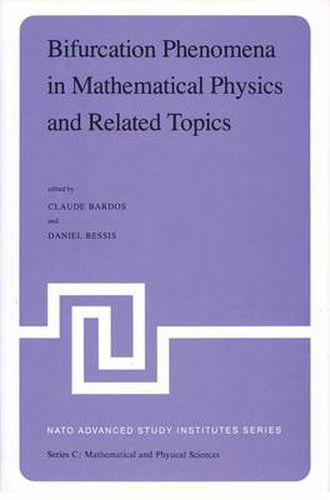Readings Newsletter
Become a Readings Member to make your shopping experience even easier.
Sign in or sign up for free!
You’re not far away from qualifying for FREE standard shipping within Australia
You’ve qualified for FREE standard shipping within Australia
The cart is loading…






This title is printed to order. This book may have been self-published. If so, we cannot guarantee the quality of the content. In the main most books will have gone through the editing process however some may not. We therefore suggest that you be aware of this before ordering this book. If in doubt check either the author or publisher’s details as we are unable to accept any returns unless they are faulty. Please contact us if you have any questions.
One of the main ideas in organizing the Summer Institute of Cargese on Bifurcation Phenomena in Mathematical Physics and Related Topics was to bring together Physicists and Mathematicians working on the properties arising from the non linearity of the phenomena and of the models that are used for their description. Among these properties the existence of bifurcations is one of the most interesting, and we had a general survey of the mathematical tools used in this field. This survey was done by M. Crandall and P. Rabinowitz and the notes enclosed in these proceedings were written by E. Buzano a]ld C. Canuto. Another mathematical approach, using Morse Theory was given by J. Smoller reporting on a joint work with C. Conley. An example of a direct application was given by M. Ghil. For physicists the theory of bifurcation is closely related to critical phenomena and this was explained in a series of talks given by J.P. Eckmann, G. Baker and M. Fisher. Some related ideas can be found in the talk given by T. T. Wu , on a joint work with Barry Mc Coy on quantum field theory. The description of these phenomena leads to the use of Pade approximants (it is explained for instance in the lectures of J. Nuttall) and then to some problems in drop hot moment problems. (cf. the lecture of D. Bessis).
$9.00 standard shipping within Australia
FREE standard shipping within Australia for orders over $100.00
Express & International shipping calculated at checkout
This title is printed to order. This book may have been self-published. If so, we cannot guarantee the quality of the content. In the main most books will have gone through the editing process however some may not. We therefore suggest that you be aware of this before ordering this book. If in doubt check either the author or publisher’s details as we are unable to accept any returns unless they are faulty. Please contact us if you have any questions.
One of the main ideas in organizing the Summer Institute of Cargese on Bifurcation Phenomena in Mathematical Physics and Related Topics was to bring together Physicists and Mathematicians working on the properties arising from the non linearity of the phenomena and of the models that are used for their description. Among these properties the existence of bifurcations is one of the most interesting, and we had a general survey of the mathematical tools used in this field. This survey was done by M. Crandall and P. Rabinowitz and the notes enclosed in these proceedings were written by E. Buzano a]ld C. Canuto. Another mathematical approach, using Morse Theory was given by J. Smoller reporting on a joint work with C. Conley. An example of a direct application was given by M. Ghil. For physicists the theory of bifurcation is closely related to critical phenomena and this was explained in a series of talks given by J.P. Eckmann, G. Baker and M. Fisher. Some related ideas can be found in the talk given by T. T. Wu , on a joint work with Barry Mc Coy on quantum field theory. The description of these phenomena leads to the use of Pade approximants (it is explained for instance in the lectures of J. Nuttall) and then to some problems in drop hot moment problems. (cf. the lecture of D. Bessis).